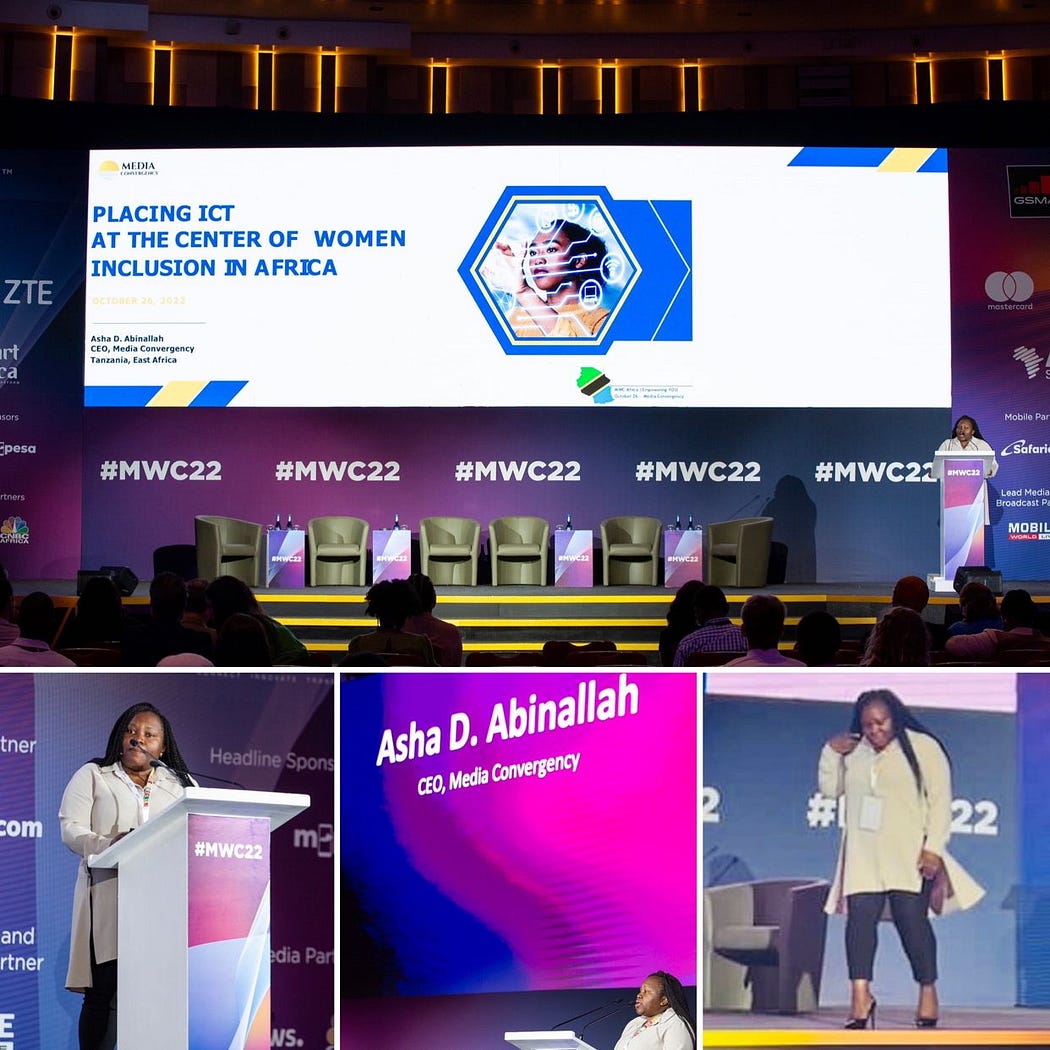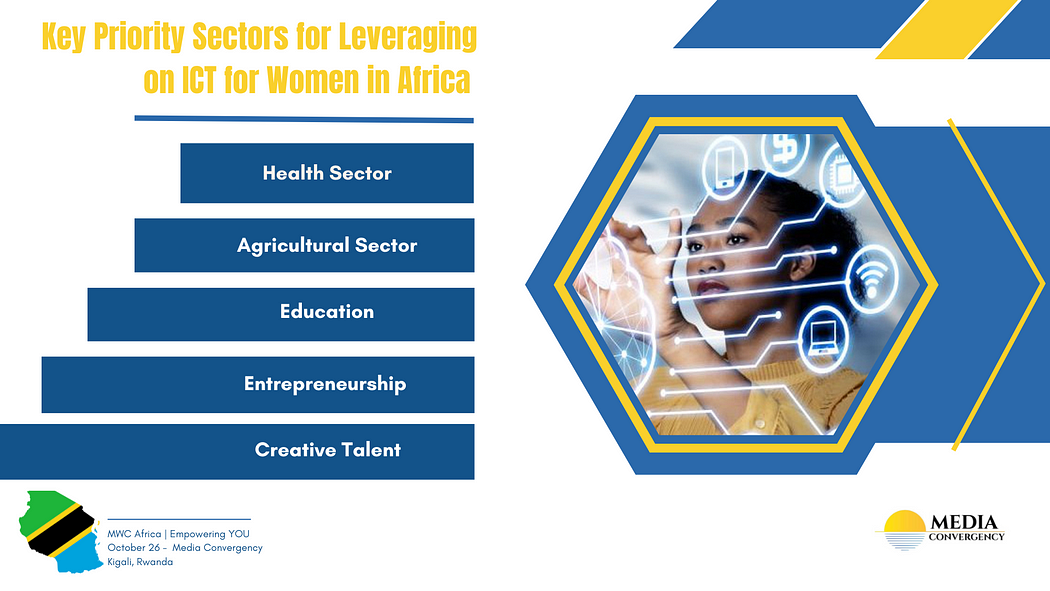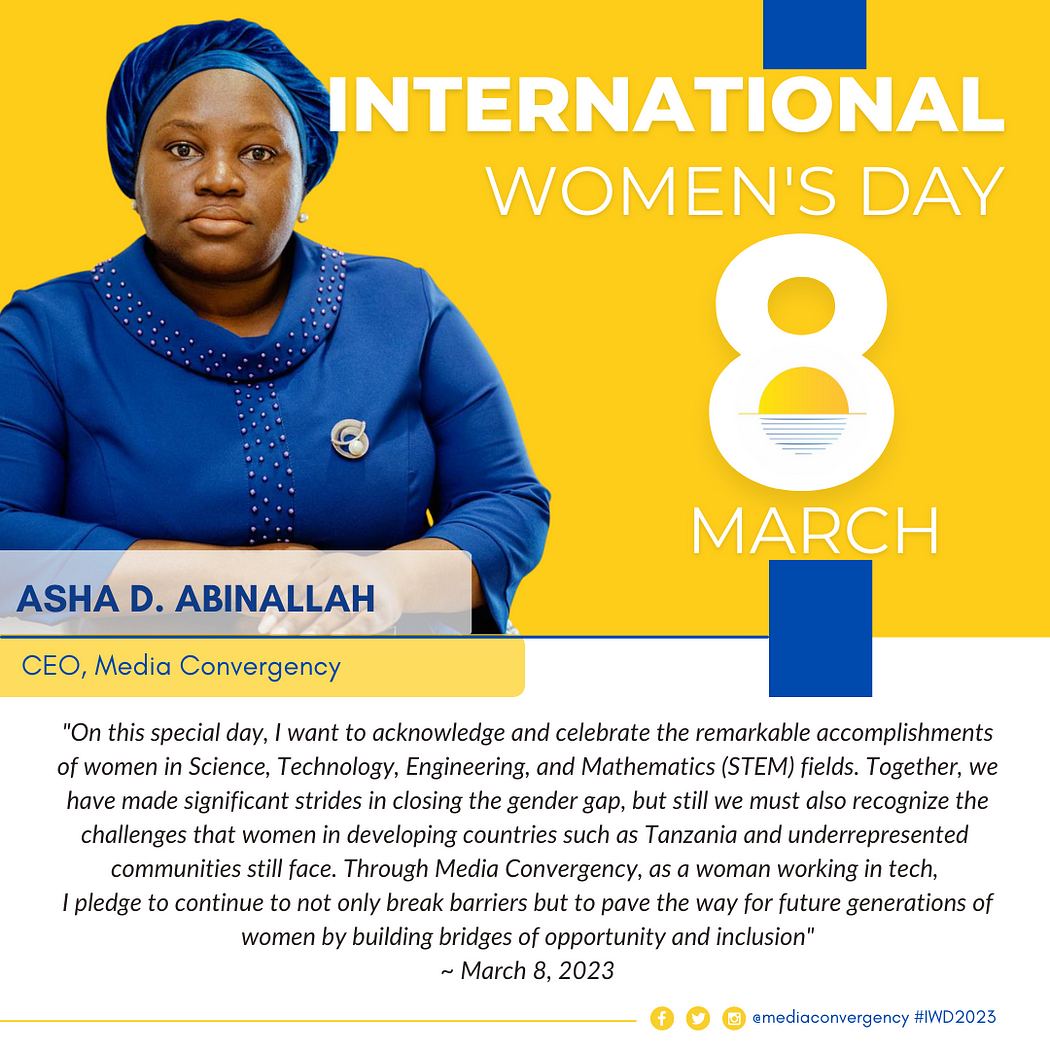Placing ICT at the center of Women’s Inclusion in Africa
Today as we celebrate International Women’s Day with the theme “DigitALL: Innovation and technology for gender equality” I take this opportunity to write an article that compliments and fits in the theme of this year’s International celebration for my fellow women.
I was honored to deliver a keynote presentation at the #MWC2022 conference on the 26th of October 2022 representing Tech & Media Convergency (TMC). The conference is GSMAAfrica’s flagship Mobile Industry and Technology event that brought together thought leaders held at the Kigali Convention Center, in Rwanda. I addressed the thematic topic “Placing ICT at the center of Women Inclusion in Africa” demonstrating how Governments and Organizations must work towards the advancement and equal opportunities for \Women by integrating with Technology in shaping the future of Tanzania and the continent at large.

The Education, social inclusion, and economic integration of African women have already started shaping the future of the continent, with sub-Saharan Africa boasting the world’s highest rate of female entrepreneurs. For the region to progress this growth, this presentation looks into how governments and organizations must work towards the advancement and equal opportunities for women by integrating technology with programs that have been shown to work and developing new ways to encourage women’s empowerment and self-reliance.
Why an ICT-centric Approach for Women’s Programs and Initiatives in Africa?
An ICT-centric approach is essential for women’s programs and initiatives in Africa because it promotes gender equality and equal opportunities help overcome barriers and accelerates progress toward sustainable development goals.
The 4th Industrial Revolution
The Fourth Industrial Revolution (4IR) is characterized by the convergence of technologies such as artificial intelligence, robotics, and the Internet of Things. While these technologies have the potential to drive economic growth and create new opportunities, they also pose challenges such as job displacement, growing inequality, and ethical concerns. To ensure that the benefits of 4IR are shared by everyone and to mitigate its negative impacts, it is crucial to place women at the center of ICT.
Placing women at the center of ICT can help create a more inclusive, human-centered future by addressing gender gaps and promoting gender equality. When women are involved in the design and development of technology, it is more likely to meet the needs of diverse users and address social challenges. This can lead to innovative solutions that improve the lives of women and girls and promote gender equality.
ICT is Male Dominated
The gender digital divide refers to the gap between men’s and women’s access to and use of information and communication technologies (ICTs). Unfortunately, women are often underrepresented in the ICT sector, both as users and as professionals. This gender imbalance in ICT is especially pronounced in rural areas, where women face additional challenges such as limited access to education and training, as well as cultural and social barriers. Intentional initiatives are crucial for reducing the gender digital divide because they aim to address this imbalance by intentionally prioritizing women’s needs and experiences.
These initiatives can take many forms, such as government policies, private sector initiatives, and civil society programs. They can target different aspects of the gender digital divide, such as access to technology, digital skills, and literacy, as well as opportunities for women in the ICT sector. I am happy that through Tech & Media Convergency (TMC) we have, Women At Web Tanzania, a program that is part of the regional movement (involving countries of Tanzania, Uganda, Kenya, and Rwanda).
Intentional initiatives should also consider the intersectionality of gender with other factors such as socioeconomic status, race, ethnicity, and age, as these factors can compound the barriers that women face in accessing and using ICTs.
The Future of Work, Efficiency, and Productivity
Simply put, the future of work is a projection of how work, workers, and the workplace will evolve in the years ahead. It’s a topic that keeps. While much focus is placed on technology in future-of-work discussions, other factors, such as remote employment and the gig economy, play a large role in not only how work will be done, but also who will be doing it and from where. It should not be forgotten that, Technology is a valuable asset for productivity and efficiency. The most important component is understanding what kind of technological solution best fits the services and goods offered. This is two ways. Those solutions targeting and women’s involvement as well as initiatives started by women themselves.
Internet as a Human Right
The UN has called for universal access to the internet by 2030. Internet access was declared a human right by the UN at the UN Human Rights Council. The resolution — led by a core group of Brazil, Nigeria, Sweden, Tunisia, and the United States, and co-sponsored by 70 countries from all regions — was adopted by a vote with strong support at the Council on 13 July 2021. The resolution also recognizes the disproportionate effects of the digital divide on vulnerable and disadvantaged populations, including women, children, people with disabilities, and the poor. It also acknowledges that the COVID-19 pandemic has made the digital divide even more apparent and severe, making universal internet access even more important for guaranteeing equal access to healthcare, education, and employment prospects.
In order to attain sustainable development goals, the resolution calls on nations to take action to close the digital gap and boost ICT use. This involves advocating for laws and plans that support widespread and inexpensive internet access, making investments in digital infrastructure, and boosting initiatives for digital literacy and skill development.
Key Priority sectors recommend leveraging ICT for women in Africa

How Governments and Organizations can place ICT at the center of Women’s inclusion in Africa?
Intentional Inclusion of Women in ICT related roles and fields
This addresses aspects such as:-
- The number/presentation of Positions held by Women in ICT-related Sectors. Eg, Ministries, Respective Authorities, and Institutions.
- Providing Opportunities to enhance career Growth in ICT for women
Innovation and Application of Emerging & Applied Technologies in the Agricultural & Entrepreneurship Sector
- Women account for 50% of the agricultural workforce in most Eastern and Southern African countries.
- Agricultural activities are based in Rural Areas. This calls for enhancing access to the Internet Access to rural areas without forgetting reliable power supply.
- What are we Innovating? What kind of Technologies are we using? Is it Gender inclusive? Can it go beyond the Urban? Is the Technology user-friendly? Are their Intentional Strategies in Place to promote the Agri-Tech Sector in a way it Empowers the Women in the Agricultural Chain?
Leveraging on Mobile Money (E-Money) Transfers as Financial Security
- Rural small/mid-holder women farmers have limited access to reliable financial and banking facilities for a lack of security.
- The World Bank reported In sub-Saharan Africa, only 37% of women have a bank account, compared with 48% of men.
- Data from UNDP estimates that failing to include women fully in economic life costs sub-Saharan Africa $95bn in lost productivity every year.
Support Tech-centric Initiatives targeted at Women
- Addressing dropouts of Girls in STEM as they grow older into careers. While the number of Girls studying Stem is increasing, those in careers are dropping.
- Creating supportive networks that work and a nurturing body in their careers.
- Lubricative salaries for Women as Men in the same positions across ICT-related sectors.
- Leverage on Gender-Centric Data of Women Inclusion in ICT related studies, initiatives, programs, and strategies
Supporting “Digital Creative Talents” of Women in Africa
- To acknowledge the Informal sector of Creativity using emerging or applied Technological solutions.
- Women (and especially young women) are doing very great in the Digital Creative Sector; a promising area for solving part of the Unemployment challenge in this nation. This is most important through the “GIG Economy”. Support is in the form of making sure that all the above looks at the individual perspective of the young who are embracing the ICT world for self-employment.
Reform of the Legal Framework and Regulations
- Give priority to laws and regulations governing the Cyber Space by acknowledging that OGBV is a big issue and not to be underestimated.
- Creating enabling policies and regulations that enhance Women’s Involvement and Participation in the field of STEM across Sectors.
- Addressing the approaches and affirmative actions if they promote Women’s Inclusion in STEM
To commemorate the day, my pledge lies in the greetings in the post below.


